Last year, along with many other folk in the “foodie” world, I eagerly watched the first season of Stanley Tucci: Searching for Italy. I enjoyed the scenery and the food, especially the food, and I liked that in each of the six episodes, at some point or another, he took the time to learn how to make a particular local dish, from someone who presumably knew what they were talking about. I wasn’t all that enamored of Tucci himself, finding his tour guide style to be a bit dull, as did a whole lot of critics out there, but I loved that he took the time to learn something instead of expounding on what he already knew about the dish (as too many past food-travel shows have tended to do).
And so, I took each of those six recipes and recreated them as best I could given the demonstration clips. It was obvious that they didn’t show every single step, and so I had to fill in a bit with my own cooking background, or from a bit of research, but on the whole, they were really well done. And, I had some delicious surprises along the way. Last year I featured two at a time in my write-ups, with Campania (Naples, Spaghetti alla Nerano) and Lazio (Rome, Frittata di rigaglie di pollo), then Emilia-Romagna (Bologna, Tagliatelle al ragú) and Lombardia (Lake Como, Riso con persico), and finishing up with Tuscany (Livorno, Cacciucco) and Sicily (wine country, Pasta alla Norma). It made for some great eating and drinking!
This year, for the second season, which aired in May, but I’m just getting around to, there were only four episodes. Let’s jump in to the first, as he travels to the Veneto, spending most of his time in the city of Venice, and goes for a classic local risotto using an ingredient that many of us have heard about, but few of us have probably cooked… let alone eaten.
The dish, Risotto alla nero di seppia, translating loosely as black cuttlefish risotto. And, that’s the unusual ingredient…
…cuttlefish. It’s different from squid, or calamare. If you’ve ever cooked with squid you can see it’s a different shape, the fins are different, running along the sides of the body rather than being two small triangular ones at the base. The head is broader than a squid’s. You can’t see, but, maybe the evidence because of the way it’s been cleaned, by slitting open the underside, is that while a squid has a long thin “pen” of cartilage as a sort off backbone, a cuttlefish actually has a shell, inside of it, that contains its innards. Here, I can only buy them frozen, pre-cleaned, in Chinatown; I’ve never seen them elsewhere.
In the first photo we have carnaroli rice, one of the three classic risotto rices (along with arborio and vialone nano), the cuttlefish, an onion, some tomato passata (uncooked, but strained of seeds and skin, pureed tomato, while tomato puree is cooked down until thicker), some white wine, butter, pecorino romano (a sheep’s milk grating cheese from the area around Rome), and cuttlefish ink. I was actually surprised to find the latter, figuring I’d only find squid ink, but, the Chinese market had both! Off to the side, a pot of fish stock (fish head/bones, celery, onion, simmered in water for about half an hour, then strained) – keep it hot over a very low flame when you’re ready to start cooking the risotto. It can be refrigerated and reheated if you want to make it in advance.
I ended up only using about half the cuttlefish, as it became clear it was going to be too much for what I needed. Cut into small pieces, tentacles and body, and into a pan with some olive oil, salt, and pepper, over low heat.
There’s a traditional kitchen rule when it comes to squid, cuttlefish, and octopus cooking – “30 seconds or 30 minutes”. The former to just quickly cook something, usually poaching in boiling water, to just set it, without getting rubbery, the latter to slow cook it until the point when the muscle fibers relax again as they start to break down. So I kept this over very low heat for about 10 minutes, until it was just turning golden.
Deglaze with white wine. Continue over low heat until the wine had reduced by about 2/3. About 5 minutes.
Add the tomato passata and an equal amount of the fish stock, and cook another 5 minutes to reduce. Set this aside.
In another skillet, begin sautéing the finely chopped onion in a little olive oil, with just a pinch of salt. Very low heat! About five minutes until soft and transluscent.
Add the rice and stir to coat with the oil, and let it toast, about two minutes.
Add two ladlefuls of the stock, and stir vigorously for about twenty seconds to start releasing the starch from the rice. As the liquid is absorbed, you add one ladleful at a time, each time giving it a good stir for about twenty seconds, and then let it sit to absorb. You don’t have to constantly stir, as some suggest, but you do have to do it at the addition of each ladle of stock. This gets the starch and water to create that creamy texture that a proper risotto has.
Rough estimate, depending on your rice, your stock, and your flame, it will take 15-18 minutes until the rice, when you check it, is soft, but still maintains a chewiness. It’s not quite ready to eat, but you sense that it’s almost there.
Add the packet of ink, and stir to combine.
Add the reserved cuttlefish mixture, and stir well. Continue cooking for about five minutes. You probably won’t need any more of the stock, because there’s enough liquid in the cuttlefish and tomato mixture to finish cooking the rice. If you feel like it’s still too chewy for your tastes, add another ladle of the stock and continue cooking. Repeat as needed – but my guess is you won’t need to do that.
And finally, what’s called the mantecada, the buttering of the risotto – add the butter and grated cheese and stir vigorously to emulsify it into the risotto liquid that remains. This gives the risotto its final richness. Taste for salt and pepper, add as needed. I found the salt level was fine (don’t add it before you add the cheese, because the pecorino is fairly salty), but I wanted a bit of a pepperiness to it, and gave it a dozen grinds or so.
And, serve! Some people decorate it with a little chopped parsley or other herbs, just for color, but for me, it’s not necessary.
As I did in last year’s posts, I wanted to seek out local wines that were reminiscent of the regions that the dishes are from. Now, for the Veneto, and a seafood dish, the obvious choice might be a Prosecco, and we do have them available here, but I thought that it would be too light for this dish, and, it was chilly and rainy out and I wanted a red. And it just happened that I knew I had a bottle of this Uruguayan Tannat ripasso. While not unique to the Veneto, the ripasso method is a common one in the region, a sort of partial pathway towards an Amarone. And while Tannat wouldn’t be the grape used, I thought that the softness of this approach to winemaking would be perfect for the dish. And, it was. This bottle was a gift from my friends at Viñedo de los Vientos, named after, if I recall correctly, one of their grandfathers, Angel’s Cuvee 2004. Rich, soft, dark fruit flavors, really just perfect drinking after time in the bottle.
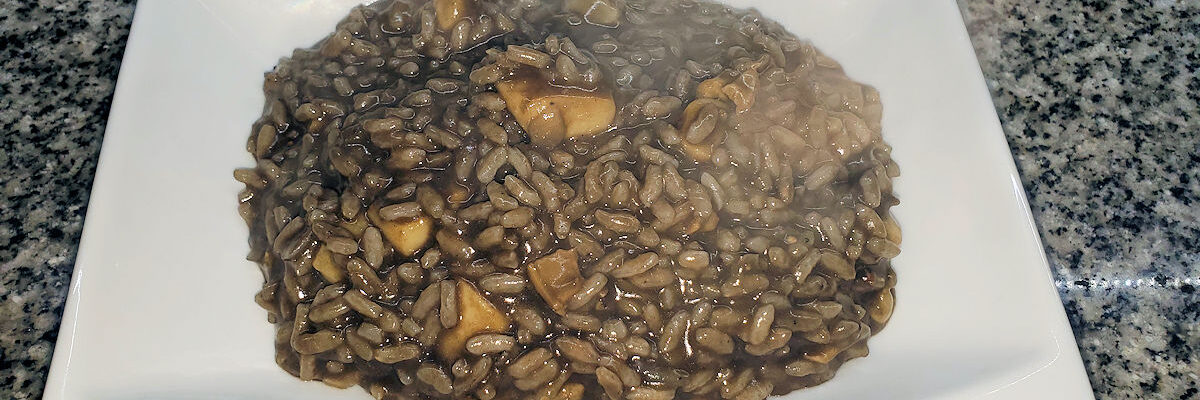
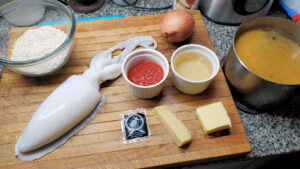
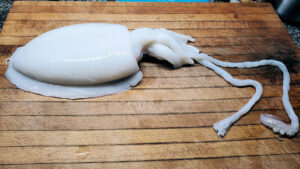
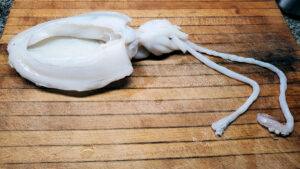
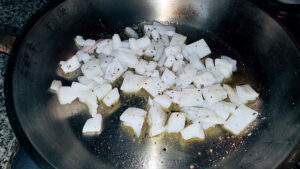
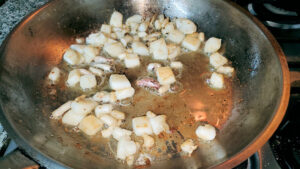
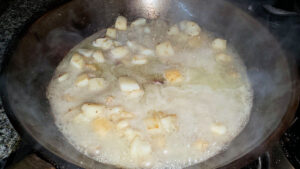
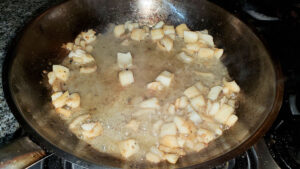
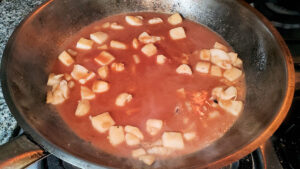
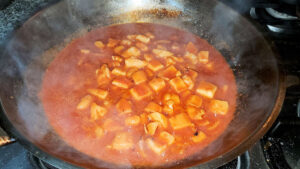
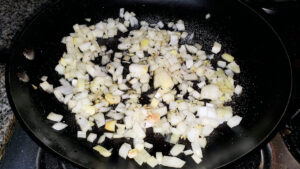
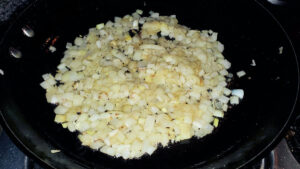
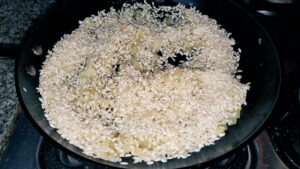
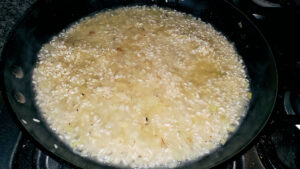
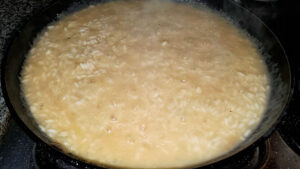
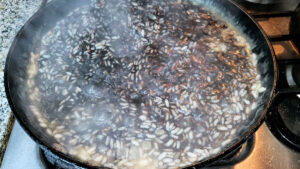
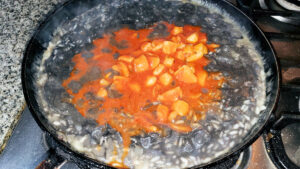
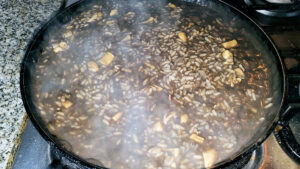
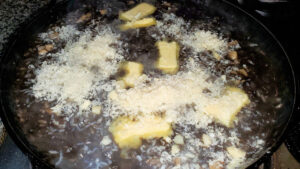
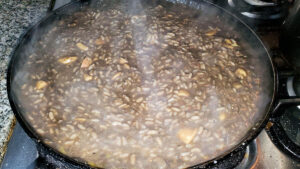
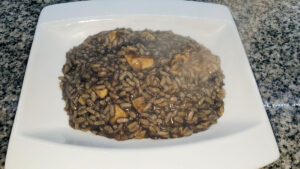
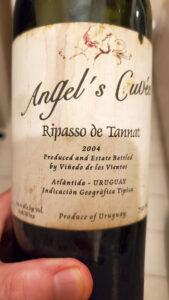
[…] in the stock, stirring regularly – I covered the step-by-step and reasons for each step in my last Tucci post. When the rice is cooked a perfect al dente, whisked in a little cold butter to give it some […]
[…] Negro de Sepia – I promised back when I did the Tucci re-creation of this dish that it’d show up on a menu soon, and here it is! I love this risotto. I just wish cuttlefish […]